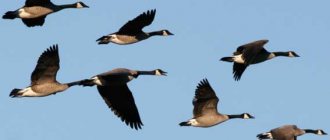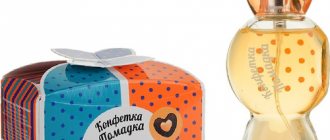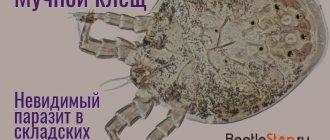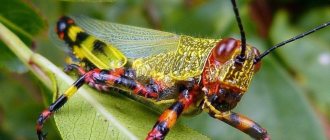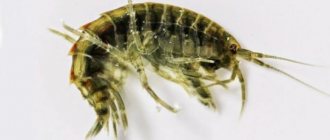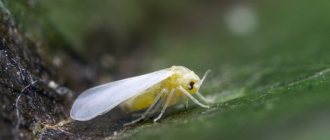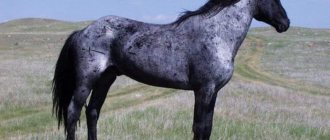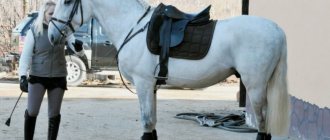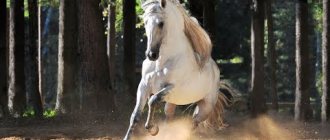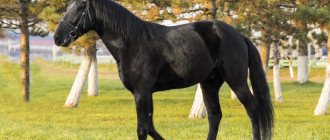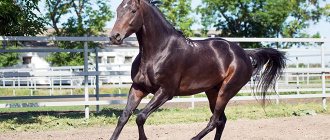Experts believe that there are no pure wild horses left in the modern world. Free-ranging “wild horses” live in national parks and are under human care. In severe winters they are provided with hay, and in drought they are provided with a watering hole. However, keepers try to minimize contact with the horses so that they retain the distrust of humans characteristic of wild animals.
Tarpans
The first wild horses to live in Europe were tarpans. They were divided into inhabitants of the steppe and forest parts. They lived mainly in groups, led by the most active stallions. Externally, the tarpan looked like a small horse (taller than a pony); at the withers, the animal reached a size of 136 cm. You can see what the tarpan looked like in the photo below.
The European wild horse (the second name for tarpans) was of a mouse color, that is, black-brown or yellow with a brown tint. The mane was protruding, short, and dark, as was the tail. The tarpan's hooves were very dense and strong. Thick and dense wool prevented these inhabitants of Eastern Europe from freezing in winter. In winter, this wild horse lightened, becoming a sandy color. Herds of hundreds of heads could run long distances, dividing into smaller groups along the way.
Donkeys
There are two groups of donkeys: Asian and African. Asian half-donkeys are a cross between a donkey and a horse. With their light body, they more closely resemble a horse, but their voice is more like the cries of a donkey than the neighing of a horse. Today, many subspecies of half-donkeys live in Asia and the Middle East: the Mongolian kulan, fast and hardy, the Tibetan kiang, adapted to high-mountain living conditions, the Indian onager, jigetai, khur. The ancestor of the domestic donkey is the Nubian wild ass, which still lives in the bleak, rocky deserts of Africa.
It is perfectly adapted to life in a hot, dry climate. The donkey was domesticated much earlier than the horse. On average, donkeys are about a meter tall, but miniature donkeys from Sicily and India are no more than 60 cm, and in Spain, on the contrary, they are as tall as a small horse. They are extremely strong and resilient for their size and can survive on one bowl of beans a day. Donkeys have a narrow body, a flat back, thin but strong legs, long ears and a short erect mane; Everyone knows the heartbreaking donkey cry “ee-a”. Donkeys come in different colors: from black to savras, there is a black strap running along the back and there is a famous black stripe at the withers, symbolizing the cross he left in memory of the donkey that carried Jesus to execution in Jerusalem.
Przewalski's horses
The world-famous wild Przewalski's horses (or steppe horses) are now preserved in nature, but their numbers are quite modest. At the moment, no more than two thousand of these horses live on the entire planet. Including two herds live in Pripyat, where zoologists brought them in the hope of increasing the population. These are powerful, stocky animals, sandy-red in color, with a short protruding black mane and black legs.
The height at the withers of the Przewalski horse is not inferior to the tarpan - about 130 cm. The weight of one adult individual, depending on the gender, is about 300-350 kg. Externally, the animal is quite massive, round in shape, runs very fast, sensitive to extraneous sounds, and timid. Herd instincts are well developed; adult individuals protect their offspring, creating a kind of living circle around the foals in case of danger. In the next video we suggest you look at the life of Przewalski's horses in the wild.
A little historical background
It is assumed that the breed was formed over the course of a century. The roots come from domestic horses.
The fact is that during the development of territories, people often abandoned sick animals, and horses also ran away from pastures.
Naturally, no one was going to look for them; this was a pointless exercise, given the vastness of the prairies.
Animals gathered in herds and roamed in search of water and food. Some individuals died. Those that survived learned to live without humans.
Camargue
Wild horses of the Camargue (or Camargue horses) live in the Mediterranean. Outwardly, this horse is not particularly attractive, since it has a rough head and a squat but powerful body. The color is predominantly gray, the mane and tail can be either light or dark, the eyes are brown or black. These horses lead a nomadic lifestyle, and often run out in herds to the seashore, which greatly attracts tourists.
The local rural population occasionally uses the Camargue as a small draft force, like oxen or mules. Horses are also used for riding. Most of them now live in a natural reserve controlled by local authorities. Next, watch a popular, exciting video about how beautifully the Camargue gallops along the seashore.
Heck horse
Quite little is currently known about the Heck horse. This species of the equine family resembles the tarpan in the shape of its muzzle and body. The color is gray, with a gray tint. Body weight is about 400 kg. Height at the withers is 140 cm. The animals were bred by artificially crossing wild domestic specimens as part of the scientific program of the brothers Heinz and Lutz Heck (Berlin Zoo) at the beginning of the 20th century.
Currently, crosses between Heck horses and Polish conics (another wild species) live in major zoos around the world and in nature reserves in Italy, Spain and Germany.
Mule
A hybrid of a donkey and a mare is called a mule, and a hybrid of a donkey and a stallion is called a hinny. Both are sterile, so in order to get a new individual, you have to re-attract horses and donkeys. In appearance, the newly minted hard workers are more like their mother, but they inherit their character from their father. The mule was first bred 4 thousand years ago in the Middle East. He was the most useful of working animals and was valued more than horses. Even the rulers rode it. Mules are smart, resilient, strong and much more economical than horses. They cope with work in difficult conditions. Mules have a strong body and can reach a height of 155 cm. In both world wars, mules were widely used to transport ammunition, and the Indian Army still uses mules for various transportation purposes.
Polish Konik
A mousey, strong horse with a characteristic gray-black color was bred at the beginning of the last century. Its ancestor was the tarpan, and it was after its disappearance that tarpan horses or “koniks” appeared. This type of horse was initially used as working transport and draft power. Mostly Koniks lived in Belovezhskaya Pushcha (in its Polish part). Gradually they spread to the Belarusian part.
These animals now live in European zoos, interbreeding with each other and producing offspring. For 4 years now, the World Wildlife Fund (WWF) has been following a program according to which it will return the Konikov to its natural habitat in the coming decades. The size of the Konik is not very different from the Przewalski's horse - about 140 cm at the withers, weight about 400 kg, light gray, smoky body and black mane and tail. The knee joints are also black, as is the skin at the base of the hooves.
Extermination
In the 19th and 20th centuries, these magnificent animals were killed for meat and skins. During the First World War, most of the livestock was destroyed.
But even after this, their numbers continued to decrease. The reason was the small amount of grazing land.
In 1971, American authorities banned hunting of wild animals. Today the number of mustangs is no more than 20 thousand.
Mustangs
Ordinary domestic horses, wild and bred in North and South America. They were previously hunted by ethnic Americans (Indians), which is why they are currently on the verge of extinction. Outwardly they are very attractive, have a strong powerful body, developed muscles, a wavy mane and a wavy tail. The color is very different - from black to white with transitions, marks, and various undertones.
Endangered breeds
Russia at the beginning of the twentieth century was one of the most equestrian countries in the world. Having a wide variety of natural conditions, it also had a sufficient number of horse breeds adapted to specific areas. However, time and technological progress have driven the horse out of most areas of everyday life: 22% of horse breeds have already disappeared, and the numbers of 29% of breeds are either at the lower threshold of possibility of conservation, or their existence is generally questioned.
Entire layers of the history and culture of the regions and nationalities living in them are associated with indigenous breeds. The disappearance of breeds threatens the loss of national traditions and national self-identification. This truth was realized at least in Bashkiria, Tuva, Buryatia, Yakutia, where the preservation of the traditional way of life is directly related to horse breeding. Horses are used here both as labor and as a source of meat, milk, and six. In these regions, there are national programs to support horse breeding, but in general the number of horses here is quite large and does not cause concern for their continued existence.
The situation is much worse with the Mezen breed, Pechora, Priobskaya, Tavdinskaya, etc. These are horses mainly for working purposes. With the widespread introduction of mechanization in rural and private farms, the need for horsepower has sharply decreased. However, along with the disappearance of horses from villages and villages, employment decreases, folk traditions and crafts are lost, and social problems increase. So maybe national breeds and their preservation are one of the “links” of Russian society, not far-fetched, but quite real?
Mezen breed. One of the northernmost Russian breeds. Unpretentious to feed, able to walk in deep snow, these hardy horses were faithful helpers of Pomors. Now there are no more than 500 individuals left. Photo: Natalya Spasskaya, Kommersant
How do horses live in the wild?
In nature, a wild herd necessarily consists of several mares and only one male leader. He is the leader, his task is to protect and protect the mares, to cover. But the leader is the alpha female. She is usually the oldest in the herd. It is she who leads the herd to new pasture areas and keeps order.
She obeys the stallion, and the other females obey both her and the leader. Growing stallions leave the herd and unite in bachelor groups until they themselves organize a herd or select females.
The leader expels single stallions from the herd at a certain period (usually at 3 years). They are forced to either gather their herd, or join a crowd of similar individuals, and stick to the leader. By the way, the leader of the herd marks all the mares, so a “lost” stray stallion is unlikely to risk covering a mare that has been marked by another male. The smell also serves as an identifying sign for mother and calf, for the female and male who have formed a family, as well as for individuals from different breeding groups.
By the way, in North America and Asia you can often find lonely horse families in the wild - a mare, a stallion and a foal. Such individuals, living separately from the herd, prefer to live together on their favorite plain, part of the steppe, or small forest. The next video is about how the wild horses of the North American Sable Island live. Backstage by photographer Robert Dutesko.
Reproduction
The mating season begins in April and lasts until the end of July. To take possession of the best female, males have to fight, and in the literal sense.
The fights are quite fierce, the strongest wins. As a result, healthy, powerful offspring are born.
The female foals in 11 months with one foal. This happens far from the herd, but after a couple of days the mother and baby return.
By winter it grows up and becomes strong. The cub is fed for 6-8 months.
After 3 years, the grown-up stallion either leaves and or takes the herd from the old horse by force.
Photo gallery
Photo 1. Przewalski's horse in the reserve
Photo 2. Silver mustang runs across the steppe
Photo 3. Dancing in the Camargue field
